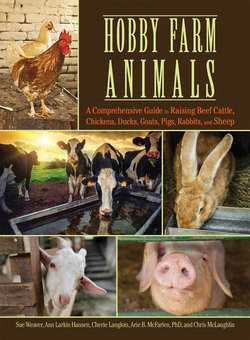Читать книгу Hobby Farm Animals - Chris McLaughlin - Страница 37
На сайте Литреса книга снята с продажи.
Selling Beef from the Farm
ОглавлениеSelling processed beef directly from your farm is known as direct marketing, and it used to be how most rural residents bought their beef for the year. Traditionally, beef is sold in wholes, halves, and quarters, referring to the proportion of the animal sold to an individual buyer. For example, when a customer buys a half of beef, they get all the meat that came from that half of the steer, from burger to steak. Processors are familiar with this method and will divide up the meat for you if you ask ahead of time. If you’re selling quarters, you can sell by front quarter (less valuable), back quarter (more valuable, with lots of steaks), or mixed quarters. With mixed quarters, you take half a carcass and evenly divide the types of meat into two portions. That way, each buyer gets the same amount of steaks, roasts, and burger. There aren’t a lot of good steaks on a front quarter.
Some direct marketers sell by the piece or by marketing each cut individually. This method means you’ll probably sell all the steaks and hamburger quickly and have a lot of roasts and round steaks left. It does attract buyers who don’t have the freezer space for an entire quarter as well as buyers who would like to try the meat before committing to a larger purchase. If you have a lot of buyers interested in hamburger, you can have cull cows made into terrific burger instead of sending them to a grade and yield operator or to auction.
Direct meat sales are regulated by the federal government. It’s illegal to sell meat across state lines unless it’s been processed in a federally inspected plant. The majority of meat-processing plants are state inspected, not federally inspected, so this is a major difficulty for direct marketers living near a state line with a good potential market on the other side. Some have solved this by having their customers drive to the farm to pay for and pick up their meat, while others truck cattle long distances to a federally inspected plant.
Finding buyers for home-grown, grain-fed beef is usually no problem. Relatives, friends, neighbors, and coworkers are all potential customers. But if you sell tough or gamey-tasting beef, you won’t get a lot of repeat business. Begin by raising and eating your beef yourself. When you’re sure of your beef’s quality, then it’s time to contact people and ask whether they’re interested in buying your beef.
Direct-marketed beef can be priced by live weight, hanging weight, or dressed weight (see “Grading Beef”). This can be very confusing to customers. The easiest method is to charge by the weight of the meat that the customer actually takes home to the freezer. With wholes, halves, and quarters, generally one per-pound price is charged, regardless of the type of meat. This means that on a per-pound basis, the burger is expensive and the steaks cheap; but averaged across the entire purchase, the price is fair. When selling by the piece, the per-pound price varies by whether it’s steak, roast, or burger, just as in a grocery store. Many direct marketers add a per-pound processing charge to the price.
Some processors will let your customers pick up their meat directly from the processing plant, while others prefer that you take the meat home, where you can either have your customers pick it up at your place or deliver to them. Specify the date and time of pickup or delivery to avoid having big heaps of meat thawing in your garage, waiting to be picked up or delivered to customers. Advance scheduling enables you to get the meat from the plant to your customers immediately.
| Grading Beef In addition to being graded by quality, beef can be graded by yield. The yield grade simply refers to the percentage of the total carcass that is usable meat, and it runs from a 1, the highest yield of edible meat, to a 5, the lowest yield. In general, a good-quality beef steer will yield about 40–50 percent of its total body weight in usable meat. Another term you may run across is carcass weight, the weight after the animal has been slaughtered and the head, hide, feet, organs, and digestive tract are removed. Carcass weight is also called dressed weight or hanging weight. Removing the bones and excess fat from the carcass gives you the cutting yield, which is expressed as a percentage of the carcass weight, not of the live weight. For example, let’s say a 1,200-pound steer yields a hanging, or carcass, weight of 725 pounds. If the cutting yield is in the 60–70 percent range, as it should be for a good beef animal, the amount of meat you’ll take home in little white packages will be 440–520 pounds. So a 60-percent cutting yield is the same as 40 percent of the live weight for this animal. |
